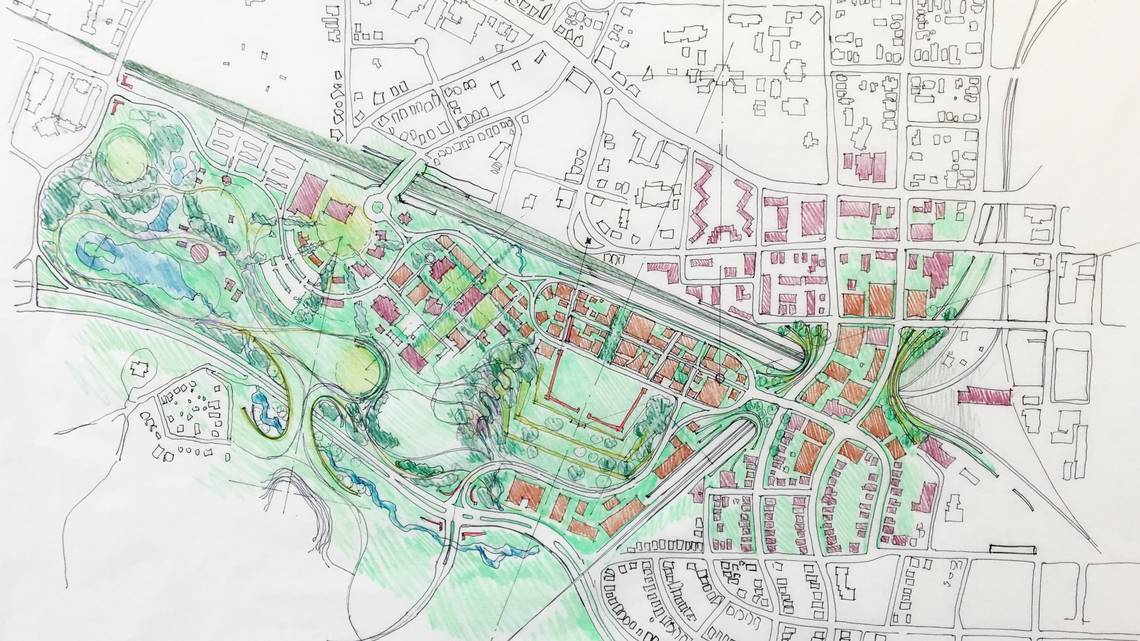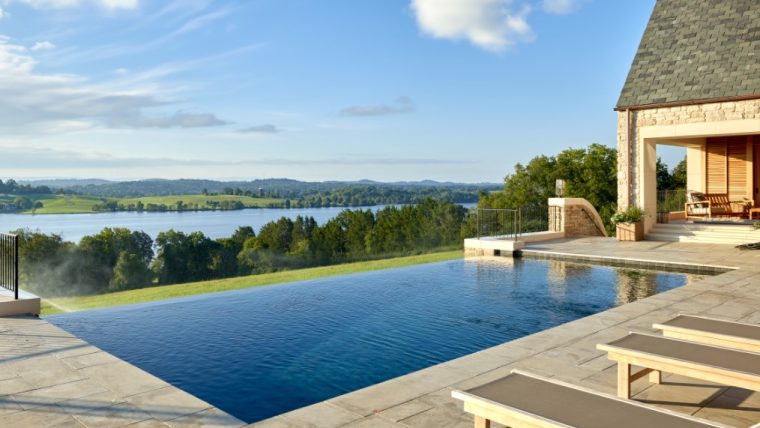From May 18-20, Triangle AIA in Raleigh, N.C. and this website partnered to develop a three-day charrette to re-imagine an 81.2-acre site in downtown Raleigh. My architecture column in The News & Observer yesterday covered the event of last weekend. A+A is reprinting the “Skyline” column here today:
RALEIGH: The assignment: Contemplate the future of 81.2 acres near downtown Raleigh, an area now occupied by Central Prison and Morehead School for the Blind.
The goal: Dream big.
Five of New York’s most gifted urban designers came to Raleigh, joining with about 70 Triangle architects, eager to sink their teeth into hypothetical, mixed-use solutions for the site off Western Boulevard.
Over the weekend of May 18-20, loaded with maps and drawings, aerial photos and transit plans, they debated possibilities for the area that’s considered a connective piece between downtown Raleigh and Dix Park. The prison may move eventually, the school redesigned.
They raised probing questions about the site, and a number of themes emerged. The main driver is to open those 81.2 acres to the rest of the city. But at the same time, how do planners balance acknowledging the site’s controversial past while also being part of the city’s vibrant future?
“They were provocative and pushed across the boundaries of the task at hand,” says Thomas Woltz, a landscape architect designing a 5-acre park for New York’s Hudson Yards.
“They gave back 200-acre, 500-acre and 2,000-acre solutions,” Woltz says. “The 81.2 acres will solve much bigger problems — and now there’s a whole menu of ideas about what to do with these sites.”
Here’s how some of those ideas emerged.
A feeling of excitement
The site was the focus of a design charrette — that’s French for an intense, fast-track workshop — called “Connections 81.2.” Over the weekend, there were opportunities for the public to join in.
The weekend was organized by AIA Triangle and Architects + Artisans. (Editor’s note: Architects + Artisans is the digital design magazine published by this writer.)
On this Saturday, the group of architects had nine hours to come up with their ideas. They gathered in a third-floor cafeteria at Citrix in downtown Raleigh’s Warehouse District as Chicago architect Todd Zima reviewed parameters for the exercise.
Directly in front of him sat four designers responsible for projects in and around Hudson Yards, the largest mixed-used development in New York since Rockefeller Center.
They included Claudia Cusumano, KPF’s project manager at 30 Hudson Yards. Beside her was Michael Samuelian, responsible for its $25 billion master plan and 17 million square feet.
The panel also included Woltz, the landscape architect; Andre Kikoski, responsible for 33 floors of luxury residential interiors at One Hudson Yards; and KPF’s Marianne Kwok, design director for two landmark towers there.
The architects broke up into six groups, combining New Yorkers with local residents.
Excitement in the room was palpable. Questions burst out, unrelenting and staccato-style: “Which buildings do we keep?” “How many are there?” “What about the land bridge?” “Don’t we need to read the grid?”
Everyone scribbled notes at once — on brown butcher paper beneath the maps, on yellow legal pads, on tablets and laptops.
Roving the room and hovering over tables were local activists and planners. Among them: Dan Gottlieb, director of planning and design at the North Carolina Museum of Art; Kate Pearce, senior planner for Dix Park; Bill Padgett, president of Dix 306; and Barbara Bacon, Morehead’s superintendent of education services for the blind
Gottlieb was important because he knows how to turn a scarred prison site into a cultural asset. Padgett and Pearce were there because Dix Park lies immediately across Western Boulevard from those 81.2 acres. Bacon was there because she knows Morehead School like the back of her hand.
Questions kept popping off: “Does this make a walkable neighborhood?” “How do we connect urban to urban?” “Are those tall buildings?”
After a half-hour of verbal back-and-forth, pens and markers were unsheathed, trace paper laid over aerials. Hands flew in multiple directions at once, making strokes, squiggles and sketches in blue, black, green, red, orange and purple.
The complex questions began to emerge: “Can’t we make that a High Line?” “What about a Peace and Justice Center there?” “Are we thinking about the ecological and emotional health of the land?”
Gradually, the room quieted as artists labored over serious sets of sketches. Later, conversations became animated, as drawings were reviewed over beers. By 6 p.m., the exercise was over, final layouts were complete and all questions answered.
Roving the room and hovering over tables were local activists and planners. Among them: Dan Gottlieb, director of planning and design at the North Carolina Museum of Art; Kate Pearce, senior planner for Dix Park; Bill Padgett, president of Dix 306; and Barbara Bacon, Morehead’s superintendent of education services for the blind.
Gottlieb was important because he knows how to turn a scarred prison site into a cultural asset. Padgett and Pearce were there because Dix Park lies immediately across Western Boulevard from those 81.2 acres. Bacon was there because she knows Morehead School like the back of her hand.
Questions kept popping off: “Does this make a walkable neighborhood?” “How do we connect urban to urban?” “Are those tall buildings?”
After a half-hour of verbal back-and-forth, pens and markers were unsheathed, trace paper laid over aerials. Hands flew in multiple directions at once, making strokes, squiggles and sketches in blue, black, green, red, orange and purple.
The complex questions began to emerge: “Can’t we make that a High Line?” “What about a Peace and Justice Center there?” “Are we thinking about the ecological and emotional health of the land?”
Gradually, the room quieted as artists labored over serious sets of sketches. Later, conversations became animated, as drawings were reviewed over beers. By 6 p.m., the exercise was over, final layouts were complete and all questions answered.
They would be addressed the next day at N.C. State’s College of Design, attended by about 100 professionals and interested community members. Some of those community members had been part of teams headed by Kwok, Cusumano and Kikoski.
“We had a planner on our team from a county outside Raleigh — he drove in to take part,” says Kwok. “And there was a woman who’d worked at a school and a prison as a horticultural rehabilitation therapist to help people grow things.”
The results
As varied as the six teams’ solutions were, a number of common concerns were raised, mainly how the property connected to Dix Park, downtown, Centennial Campus, Boylan Heights and Pullen Park.
Two distinct camps emerged during discussions. One focused on education and the scar of the prison being erased or re-imagined as a place of healing — and preventing future incarceration. The second looked at economic development — making the site a green, sustainable example for the next generation of smart cities. “It was memorialization versus what does Raleigh really need to attract folks to move downtown,” says planner Samuelian.
One consistent focal point was the 19th-century prison wall that each team wanted to preserve, but in different ways. Some wanted it used as a memorial space for those who have been executed and incarcerated, and others as a cultural centerpiece — even suggesting its potential as Raleigh’s iteration of New York’s High Line.
“We were on the centerpiece end — a community center to bring people together,” says Samuelian. “Parks are great and beautiful, but you have to activate them with people.”
So the question for his team was how to make it celebratory. And that came down to two ideas.
“It could be a big outside amphitheater like the Hollywood Bowl, for thousands of people to come together,” he says. “Or you could make it an internal cultural hub for more of a visual arts focus. I personally like the idea of a big performing arts center there.”
The built environment
A number of plans called for construction of commercial and residential buildings as tall as 12 stories near downtown, then tapering down to five and six stories and one and two stories. Open space varied from one-third to one-half of the site.
Cusumano and her team took cues from the original 1792 William Christmas Plan of Raleigh. “We focused on the Christmas grid on the eastern end, with more density and a gridded plan,” she says. “On the western side, we had a greenway from Boylan Heights that terminated north to south, with a major marketplace on the western portion of the site, a piazza and a working farm.”
Woltz proposed what he labeled “developer happiness” across from downtown as well.
“It’s a very desirable space with great views and proximity to park land,” he says. “To have developers be great partners and give it character and differentiation — that will give it years of life.”
Participants paid particular attention to the Morehead School campus, expanding and re-imagining it in new ways. Woltz’s team suggested a social services community, where life skills and retraining can be learned, the blind can learn to walk and even food stamps can be distributed.
“If you don’t have access to a bus or a car, it’s a campus concentration for emotional training and transitional services,” he says. “There can be vocational training for the transition back to a whole life, to fill in the gaps in the human condition.”
Ambitious? You bet. But it’s inspirational, too.
“We were trying to find the highest and best use,” Kikoski says. “What was so exciting about this was that the discussions included incredible cultural ambitions, economic vitality and care for members of the community — we were motivated by the shared vision that we forged.”
For more, go here.
For information and updates, go here.



